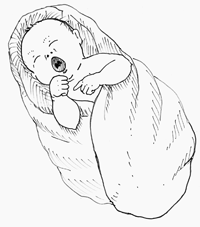STRANGE BUT TRUE- Yawn, baby: Helping babies and limbs come alive

DRAWING BY DEBORAH DERR McCLINTOCK
Q. Your nostrils and bronchial tubes just dilated, larynx and pharynx widened, diaphragm sank, tongue drifted back, heartbeat accelerated, tears and saliva welled while your jaw dropped and shimmied back and forth. Is there a doctor in the house? –J. D. Aller
A. Hold the call– you just yawned. And you're not the only one, says psychologist Ronald Baenninger: Fetuses yawn, as do newborns usually within five minutes of birth. Athletes yawn before tense contests, along with college students in libraries, with neither matching calculus students who by one count rack up 25 per hour. Bizarrely, some people paralyzed on one side of the body are able to stretch otherwise immobile limbs during a yawn. Also, while certain antidepressants may inhibit connubial desire, a few takers will find they now experience release when yawning (even forced yawns may be a trigger).
Q. If conflict is genetically programmed into our DNA, what hope do we humans have of ever taming the urge to war? –G.W. Bush
A. The premise sounds pretty fatalistic but it overlooks that peacemaking, too, is programmed into our DNA, says John Horgan in Scientific American magazine.
Emory University anthropologist Frans B.M. deWaal studies primates and notes that while lethal conflict occurs among chimpanzees– our closest genetic relatives– they reconcile after fighting by hugging, mouth and hand kissing, mutual grooming, food sharing. Among humans, reconciliation also takes place when conflicting parties stand to lose more if their relationship deteriorates.
As international economic interdependence has grown over the last century, lethal hostilities have shrunk. For example, although the European Union has not created love between Germany and France and other former adversaries, it has greatly reduced the likelihood of war.
In fact, stresses Harvard's Steven Pinker, levels of international violence are much lower in our era than before the advent of modern states some 10,000 years ago. Ethnographic evidence suggests 30 percent or more of members of tribal societies died from group violence, 10 times greater than the proportion of Europeans and North Americans killed by war-related causes even "during the cataclysmic 20th century."
Stable governments have played a part, as have mass media and travel in boosting international understanding and empathy toward those beyond our immediate family and nation.
"This may be the best news of all: civilization," Pinker says, "which has often been blamed for war, is actually helping us achieve peace."
Q. What's one of the newer, more enlightened ways of dealing with shoplifters? a) more police on the premises b) drug treatment c) patrol canines passing as "seeing- eye" dogs d) rearrangement of merchandise e) mirrors stationed to make offenders feel "on display"? –P. Bosworth
A. The surprising answer is b), treating compulsive shoplifters with an anti-addiction drug called "naltrexone," says Constance Holden in Science magazine.
People pinching a tube of lipstick or a necktie may experience a rush "similar to a cocaine or heroin high," says University of Minnesota psychiatrist Jon Grant. Naltrexone blocks the same brain receptors used by opioids though its effect on kleptomania needs more research. Still, in one eight-week study of 25 previously arrested kleptomaniacs, two-thirds had complete remission of their symptoms, suggesting an overlap between compulsive stealing and addictions in the broadest sense.
~
Send Strange questions to brothers Bill and Rich at [email protected].
#